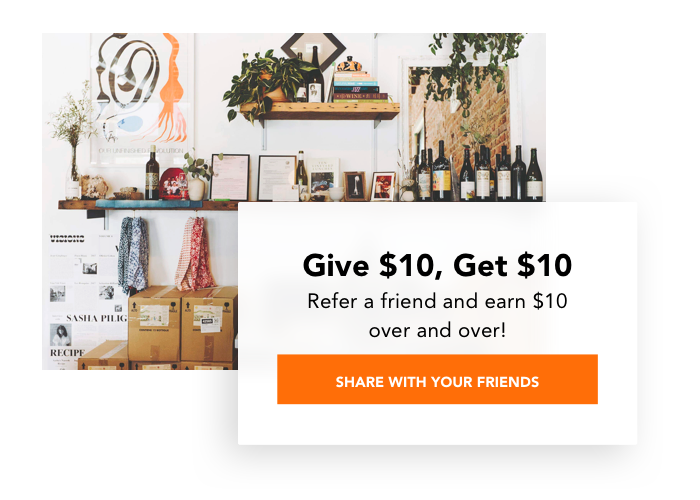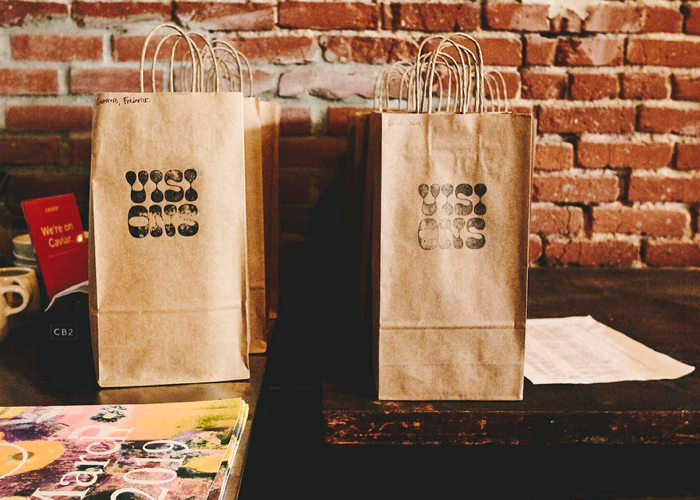Customer referral marketing (also known as word-of-mouth marketing) is exactly what it sounds like — a strategy that encourages your customers to refer their friends and family to your business. While your customers might already refer their network to your business, there are still some seriously good reasons to implement a formal strategy.
People referred to your business convert into customers faster, spend more, and are more loyal than people who aren’t referred. According to data from the Wharton School of Business, companies with formalized referral programs experience 86% more revenue growth compared to those without. Taking a proactive approach by implementing a referral marketing plan will make the news of your product or service spread like a ball rolling downhill. Reward your customers for sending out positive vibes and watch as gravity does its work.
If you don’t ask your customers to refer, they often won’t, even if they’re happy with your product or service. While 83% of satisfied customers are willing to refer others, according to research from Texas Tech, only 29% actually do. Consider the losses to your ROI from that canyon-sized referral gap. If only someone, namely you, had asked them!

Referral Incentives and Reward Structures
It’s deceptively simple in concept — Jonah likes your product and tells his friend Megan about it; she trusts him and buys the product — but it’s more complex than that. For instance, does it matter if Jonah gets cash for referring Megan or a discount on his next purchase? A Nielsen Harris Poll found that 77% of Americans prefer to be rewarded for referrals with money, so Jonah probably prefers the cash.
Can the same be said for how Megan would feel if she knew Jonah got cash for referring her? If Jonah’s benefitting from a single incentive referral program, where the referring party is the only person receiving the incentive, then probably not. Does it change things if Megan gets something, too?
It can, which is why it’s important to consider using both a referral reward, the reward you give to your customer for successfully referring folks to your business, and a referral offer, the incentive you give to referred people. In this dual incentive program, both the referrer and the referral are rewarded. When they know their friend is also getting a benefit, people are more likely to refer their friends to your product and services, so it’s a win-win-win outcome. Jonah gets cash; Megan gets a discount on your product, and you’ve just converted a new customer through your referral strategy savvy.

Choosing the Right Referral Incentives for Your Business
So how do you go about choosing the right referral strategy for your business? Referral incentives come in two types: monetary such as credit, gift cards or cash and non-monetary such as points, discounts, swag, extra product or even stock. Not surprisingly, different industries and business models benefit from different sorts of referral programs. It all comes down to your business’s product or service. Here’s a general breakdown of referral incentives and which product or service they go best with:
Product or Service Type Referral Incentive
Product or service that is frequently bought Nonmonetary such as discounts or credit toward their next purchase
Membership or subscription based product
Free month of subscription
Product that is rarely bought or only bought once Monetary such as cash or gift cards to their favorite stores
So, what makes these the right approach? It’s all about customizing the referral incentive to fit your customer base. If you, like Uber, have regular customers, you’ll want to offer them discounts to use toward another purchase. As a bonus, they’re likely to make a bigger purchase to make use of the discount. Uber decided to give referral reward credits to customers and their friends who signed up, and that was a game changer for them.
When offering discounts, remember the rule of 100. If your product costs more than $100, a flat discount is usually more enticing ($1,000 off a $20,000 car looks bigger than 5% off). If your product costs less than $100, a percentage discount is usually better — $5 off a $20 bottle of wine is better phrased as 25% off.
What if your business is subscription-based like Skillshare, an online platform that gives its subscribers access to educational videos? If you’re setting up a referral program for subscriptions, it makes sense to offer a free month of subscription to give your prospects a chance to try out your fabulous service before they buy. Skillshare offers referrals two free months and, for every referral who subscribes, the referrer gets a month free. This helps them retain their customers while, at the same time, deepening their brand loyalty.
However, these rules of thumb aren’t meant to be prescriptive. Rather, they’re a road map to the quickest route when creating your referral campaign. There are many companies that didn’t fit their referral programs into this method and have done extraordinarily well. For example, Dropbox, whose customers usually only buy their product once, set up a referral marketing program that gave more product (storage space) to both referrer and referral. Everyone, but particularly millennials and zillenials, like the idea of hooking their friends up with a good deal. Not surprisingly, through this strategy, Dropbox’s membership sign ups skyrocketed, increasing by about 60%.
Reward structures have multiple levers to adjust. When adjusting these levers, here are some questions to ask yourself:
Which platform should you market your referral program on — social media, your business website, email (email signatures and customer support emails are great opportunities to promote it) or multiple platforms?
Take note where your customers find your product and promote your campaign there. If you’ve been on Instagram recently, you’ll have noticed that referral contests, programs where people refer their network to your project, are everywhere. They take the form of tagging a friend in the comments usually for a chance to win a prize. (Who doesn’t need another branded t-shirt/bag/hat?) The more people they tag, the more likely they’ll win, and their friends can (and do) tag their friends, too. Hydroflask significantly increased their number of Instagram followers by running a contest where, in order to enter, folks had to, “follow @hydroflask & tag two friends in the comments.” Brilliance at work.
Which event will trigger the reward?
Making the reward accessible could be the difference between a successful campaign and a fruitless one. Triggering the reward when the referral clicks the link or when they make the purchase is often the right strategy, but there are cases when rewarding the referrer when sending a message makes sense too.
Will the referrer get the reward even if the referral doesn’t buy?
Consider how much money it costs to run the campaign. If you have the budget to give the referrer the reward, even if the referral doesn’t buy, it will incentivize them to keep spreading the word.
Will the reward be tiered?
Should your referrers get one reward amount for the first person they refer but a different amount for the next five? To incentivize customers to share, a company could offer $75 off for their first referral and $20 off for all subsequent referrals.
Should the reward be recurring or one time?
Think about the length of time your referral reward program will run for. Tesla and many other campaigns are successful because they know when it stops making financial sense to offer the referral reward. One option is to tier the reward so that your customer has to work harder to make the same amount. Using this method, you could filter out all but your most profitable brand ambassadors.

Measuring Your Success
There’s no point in having a customer referral program without a way to know if it’s been successful. To find out, measure the shares, clicks and conversions so you know how well your referral program is doing and what to tweak. You can do this a few ways:
- Measure referrals against other customer acquisition channels.
- Track the sharing rate (how many referral links get shared).
- Track the conversions to new customers (or referral conversion rate).
- Note the ratio of referrals per referer — you may want to reach out to those brand ambassador superstars with extra perks.
All of this takes a lot of work, which is why automation is often used to manage referral programs. With automation, you can be sure all your contacts get promos of the campaign sent directly to their inbox. Once they click, follow-up emails and rewards will trigger without you having to lift a finger. According to data gathered by Web Profits, “Only 20% of small business owners are happy with their current referral program.” Consider where you can go to get support to streamline the process so you’re spending your time where you should be.
Key Takeaways
The leading source for business growth isn’t a secret. It’s as old as enterprise itself — referrals from friends and family. It works because we trust the opinions of people we know more than we trust traditional advertising. A National Harris Poll survey of 2,000 consumers found that “82% of Americans say they seek recommendations from friends and family when considering a purchase, while 67% say they’re at least a little more likely to purchase a product after a friend or family member shared it via social media or email.”
But before you jump into the fast lane, remember to lay the groundwork for your customer referral campaign, in the form of clear rules and instructions so you don’t hit any speed bumps. You probably have a bunch of happy customers who are revving to be your brand ambassadors and refer you to their networks. Don’t let them fall into the abyss of the referral gap! Make it easy to progress from word-of-mouth referral to reward.
Create a tailored customer referral program that streamlines the process from curious friend to customer. Your customers get rewarded for their loyalty; their friends get the good things you sell, and your pipeline is filled with quality leads.